Object Modelling: Collin’s Car Parking System - Use Case & Design
VerifiedAdded on 2023/06/12
|14
|2667
|443
Case Study
AI Summary
This assignment provides an object modeling analysis of Collin’s Car Parking System, focusing on use case identification and sequence diagrams. Three key use cases are defined: ticket validation, ticket purchase, and payments, each detailing actors, descriptions, preconditions, postconditions, and no...
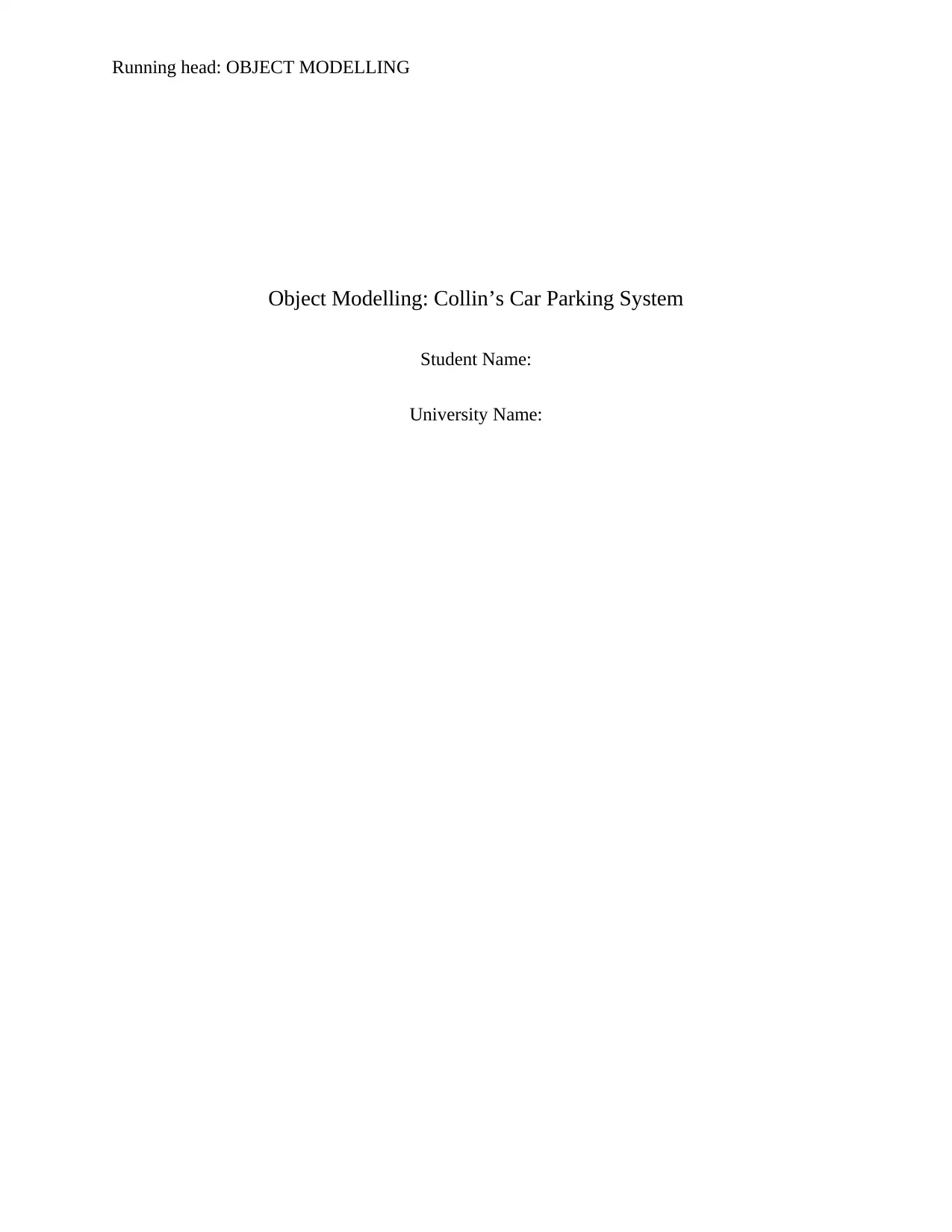
Running head: OBJECT MODELLING
Object Modelling: Collin’s Car Parking System
Student Name:
University Name:
Object Modelling: Collin’s Car Parking System
Student Name:
University Name:
Paraphrase This Document
Need a fresh take? Get an instant paraphrase of this document with our AI Paraphraser
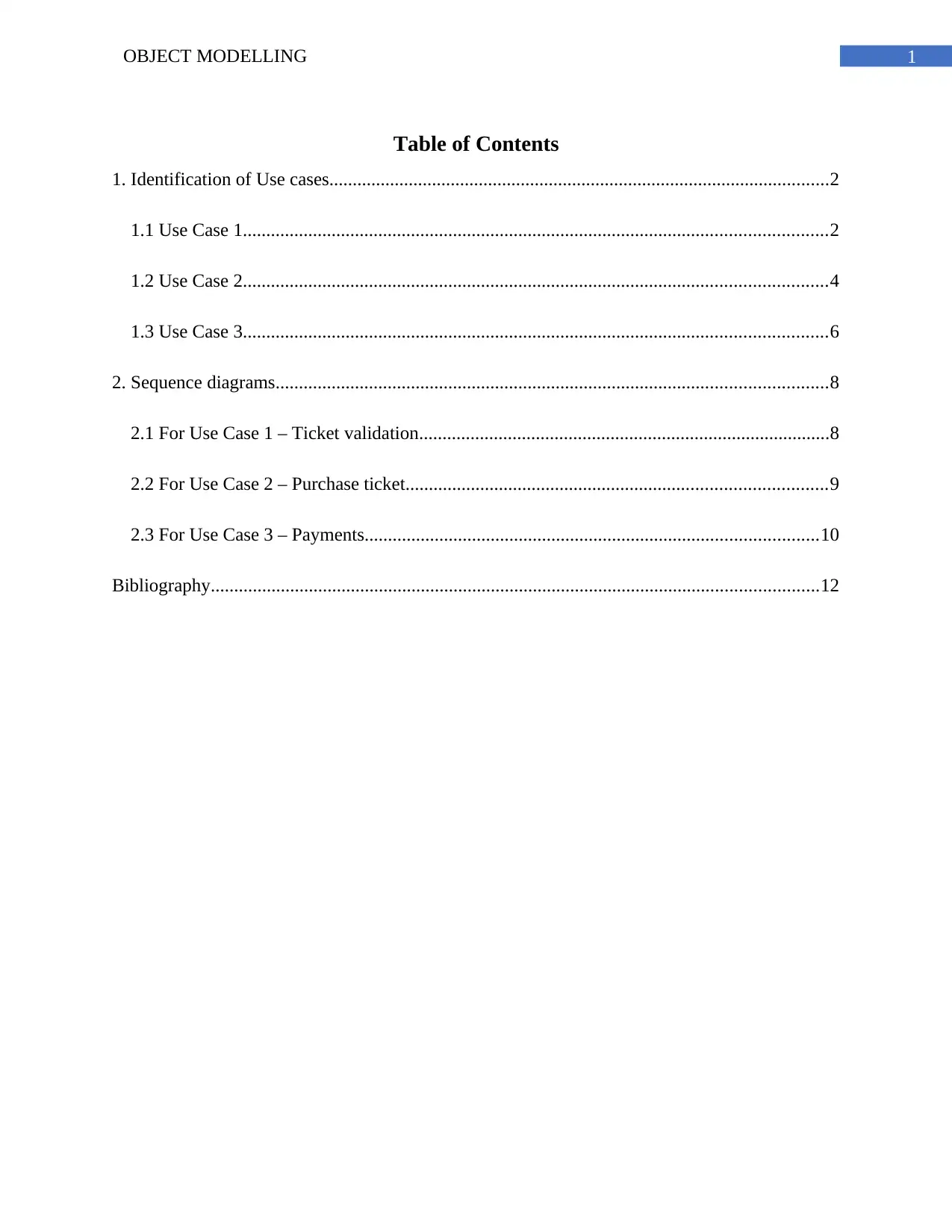
1OBJECT MODELLING
Table of Contents
1. Identification of Use cases...........................................................................................................2
1.1 Use Case 1.............................................................................................................................2
1.2 Use Case 2.............................................................................................................................4
1.3 Use Case 3.............................................................................................................................6
2. Sequence diagrams......................................................................................................................8
2.1 For Use Case 1 – Ticket validation........................................................................................8
2.2 For Use Case 2 – Purchase ticket..........................................................................................9
2.3 For Use Case 3 – Payments.................................................................................................10
Bibliography..................................................................................................................................12
Table of Contents
1. Identification of Use cases...........................................................................................................2
1.1 Use Case 1.............................................................................................................................2
1.2 Use Case 2.............................................................................................................................4
1.3 Use Case 3.............................................................................................................................6
2. Sequence diagrams......................................................................................................................8
2.1 For Use Case 1 – Ticket validation........................................................................................8
2.2 For Use Case 2 – Purchase ticket..........................................................................................9
2.3 For Use Case 3 – Payments.................................................................................................10
Bibliography..................................................................................................................................12
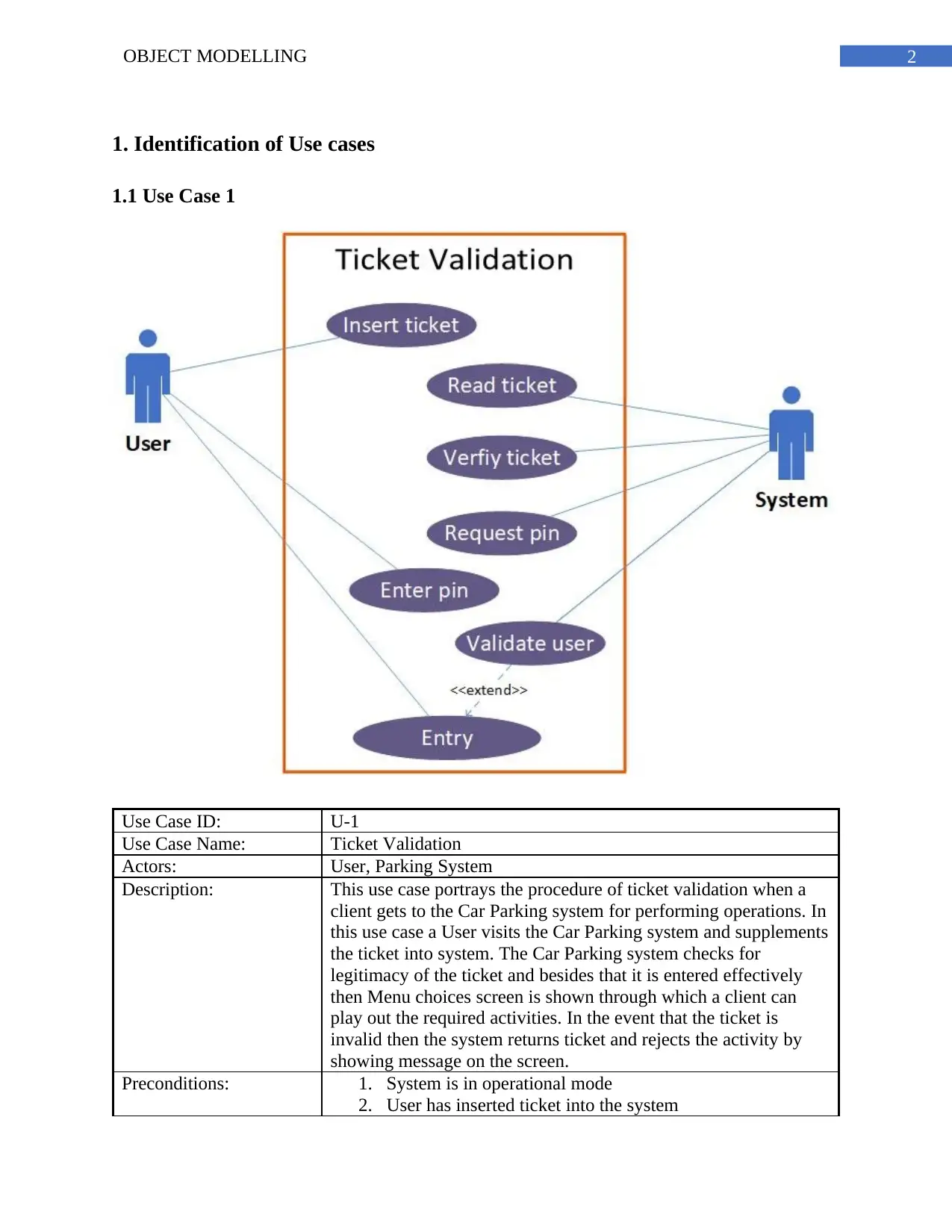
2OBJECT MODELLING
1. Identification of Use cases
1.1 Use Case 1
Use Case ID: U-1
Use Case Name: Ticket Validation
Actors: User, Parking System
Description: This use case portrays the procedure of ticket validation when a
client gets to the Car Parking system for performing operations. In
this use case a User visits the Car Parking system and supplements
the ticket into system. The Car Parking system checks for
legitimacy of the ticket and besides that it is entered effectively
then Menu choices screen is shown through which a client can
play out the required activities. In the event that the ticket is
invalid then the system returns ticket and rejects the activity by
showing message on the screen.
Preconditions: 1. System is in operational mode
2. User has inserted ticket into the system
1. Identification of Use cases
1.1 Use Case 1
Use Case ID: U-1
Use Case Name: Ticket Validation
Actors: User, Parking System
Description: This use case portrays the procedure of ticket validation when a
client gets to the Car Parking system for performing operations. In
this use case a User visits the Car Parking system and supplements
the ticket into system. The Car Parking system checks for
legitimacy of the ticket and besides that it is entered effectively
then Menu choices screen is shown through which a client can
play out the required activities. In the event that the ticket is
invalid then the system returns ticket and rejects the activity by
showing message on the screen.
Preconditions: 1. System is in operational mode
2. User has inserted ticket into the system
⊘ This is a preview!⊘
Do you want full access?
Subscribe today to unlock all pages.

Trusted by 1+ million students worldwide
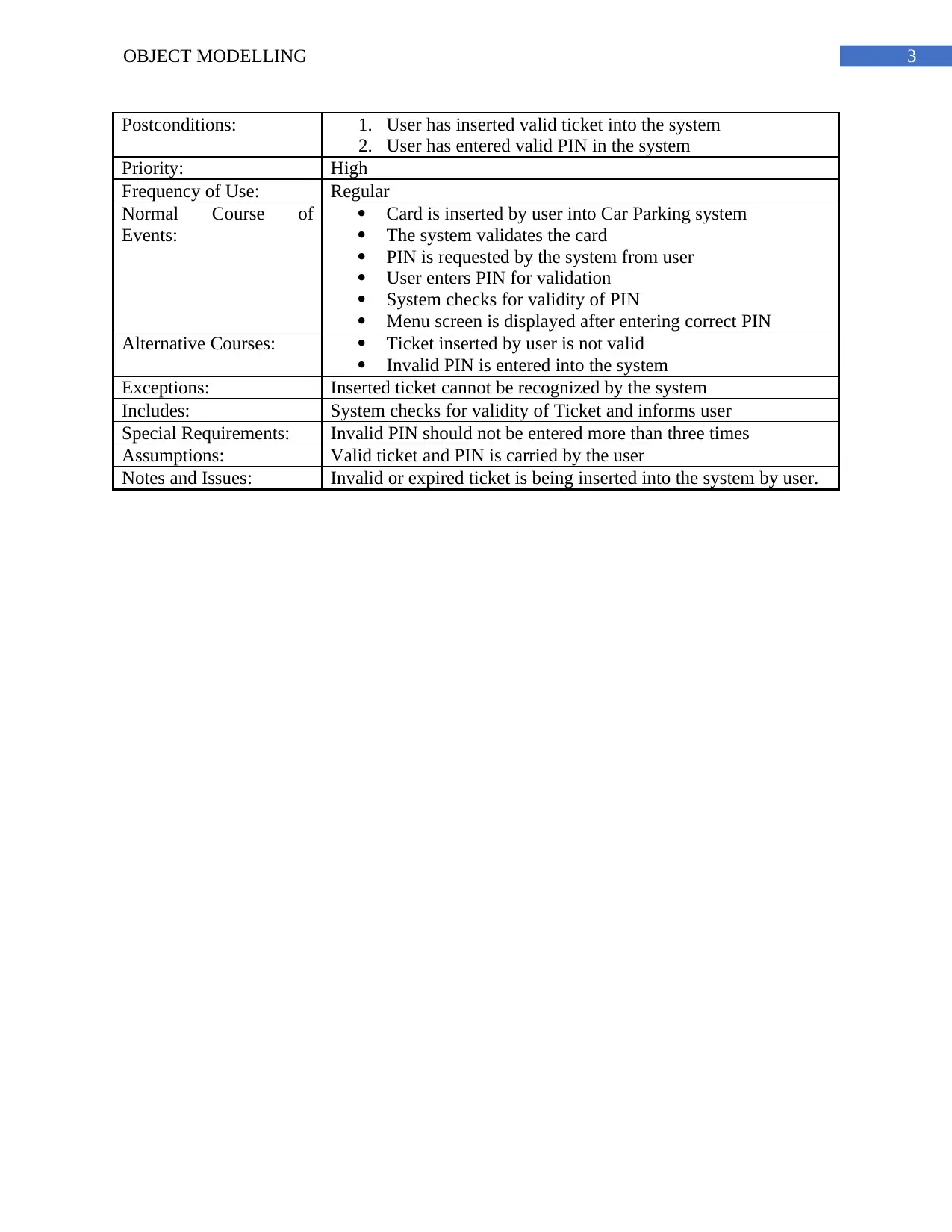
3OBJECT MODELLING
Postconditions: 1. User has inserted valid ticket into the system
2. User has entered valid PIN in the system
Priority: High
Frequency of Use: Regular
Normal Course of
Events:
Card is inserted by user into Car Parking system
The system validates the card
PIN is requested by the system from user
User enters PIN for validation
System checks for validity of PIN
Menu screen is displayed after entering correct PIN
Alternative Courses: Ticket inserted by user is not valid
Invalid PIN is entered into the system
Exceptions: Inserted ticket cannot be recognized by the system
Includes: System checks for validity of Ticket and informs user
Special Requirements: Invalid PIN should not be entered more than three times
Assumptions: Valid ticket and PIN is carried by the user
Notes and Issues: Invalid or expired ticket is being inserted into the system by user.
Postconditions: 1. User has inserted valid ticket into the system
2. User has entered valid PIN in the system
Priority: High
Frequency of Use: Regular
Normal Course of
Events:
Card is inserted by user into Car Parking system
The system validates the card
PIN is requested by the system from user
User enters PIN for validation
System checks for validity of PIN
Menu screen is displayed after entering correct PIN
Alternative Courses: Ticket inserted by user is not valid
Invalid PIN is entered into the system
Exceptions: Inserted ticket cannot be recognized by the system
Includes: System checks for validity of Ticket and informs user
Special Requirements: Invalid PIN should not be entered more than three times
Assumptions: Valid ticket and PIN is carried by the user
Notes and Issues: Invalid or expired ticket is being inserted into the system by user.
Paraphrase This Document
Need a fresh take? Get an instant paraphrase of this document with our AI Paraphraser
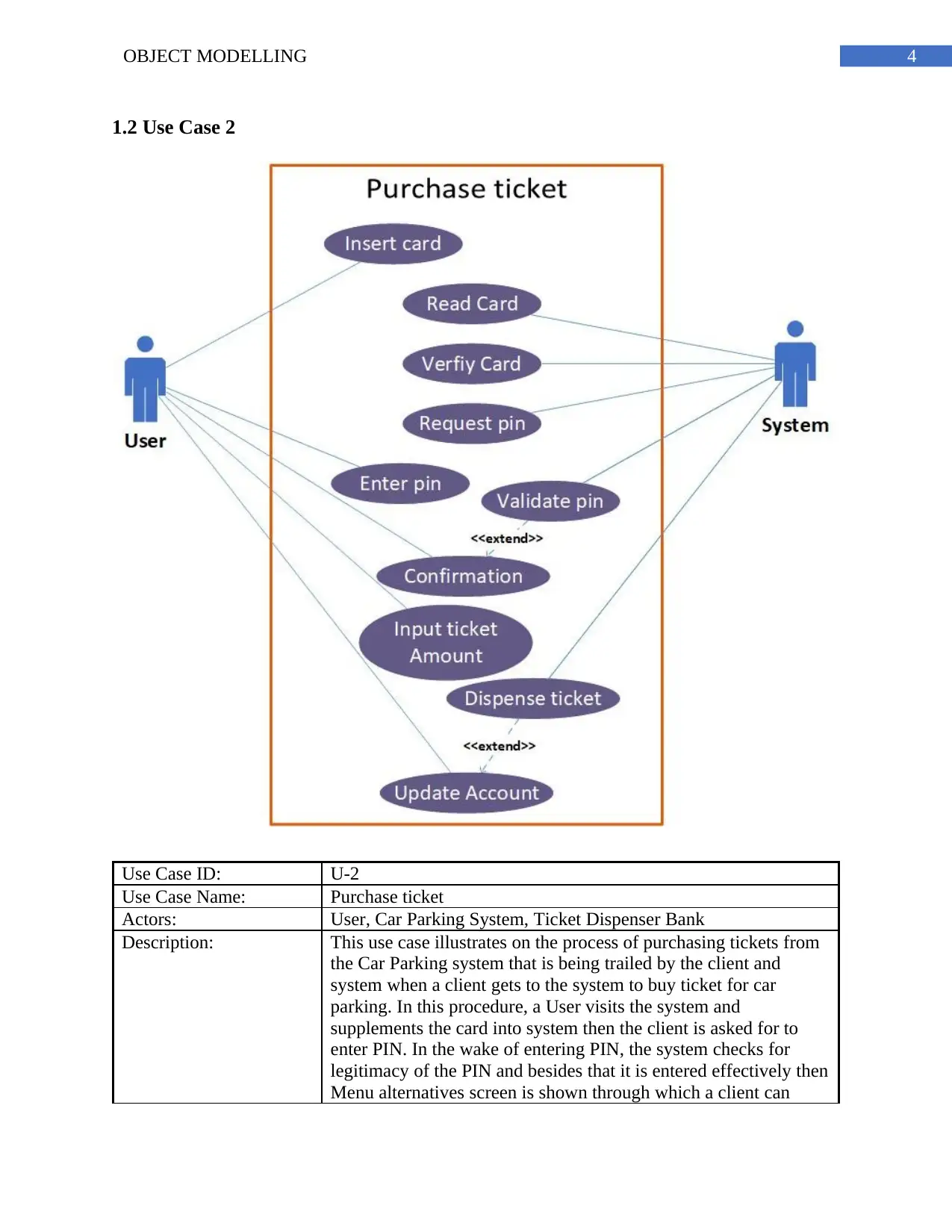
4OBJECT MODELLING
1.2 Use Case 2
Use Case ID: U-2
Use Case Name: Purchase ticket
Actors: User, Car Parking System, Ticket Dispenser Bank
Description: This use case illustrates on the process of purchasing tickets from
the Car Parking system that is being trailed by the client and
system when a client gets to the system to buy ticket for car
parking. In this procedure, a User visits the system and
supplements the card into system then the client is asked for to
enter PIN. In the wake of entering PIN, the system checks for
legitimacy of the PIN and besides that it is entered effectively then
Menu alternatives screen is shown through which a client can
1.2 Use Case 2
Use Case ID: U-2
Use Case Name: Purchase ticket
Actors: User, Car Parking System, Ticket Dispenser Bank
Description: This use case illustrates on the process of purchasing tickets from
the Car Parking system that is being trailed by the client and
system when a client gets to the system to buy ticket for car
parking. In this procedure, a User visits the system and
supplements the card into system then the client is asked for to
enter PIN. In the wake of entering PIN, the system checks for
legitimacy of the PIN and besides that it is entered effectively then
Menu alternatives screen is shown through which a client can
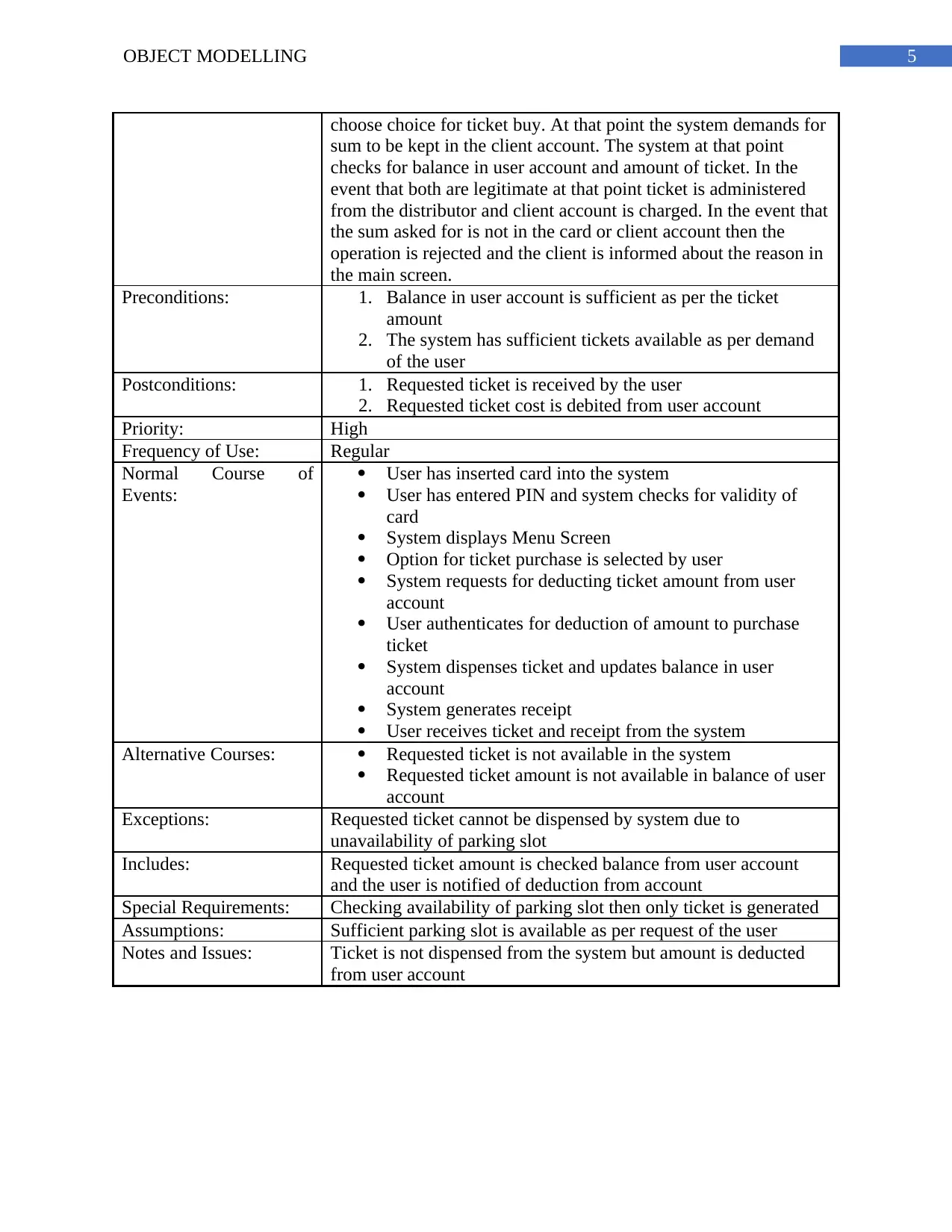
5OBJECT MODELLING
choose choice for ticket buy. At that point the system demands for
sum to be kept in the client account. The system at that point
checks for balance in user account and amount of ticket. In the
event that both are legitimate at that point ticket is administered
from the distributor and client account is charged. In the event that
the sum asked for is not in the card or client account then the
operation is rejected and the client is informed about the reason in
the main screen.
Preconditions: 1. Balance in user account is sufficient as per the ticket
amount
2. The system has sufficient tickets available as per demand
of the user
Postconditions: 1. Requested ticket is received by the user
2. Requested ticket cost is debited from user account
Priority: High
Frequency of Use: Regular
Normal Course of
Events:
User has inserted card into the system
User has entered PIN and system checks for validity of
card
System displays Menu Screen
Option for ticket purchase is selected by user
System requests for deducting ticket amount from user
account
User authenticates for deduction of amount to purchase
ticket
System dispenses ticket and updates balance in user
account
System generates receipt
User receives ticket and receipt from the system
Alternative Courses: Requested ticket is not available in the system
Requested ticket amount is not available in balance of user
account
Exceptions: Requested ticket cannot be dispensed by system due to
unavailability of parking slot
Includes: Requested ticket amount is checked balance from user account
and the user is notified of deduction from account
Special Requirements: Checking availability of parking slot then only ticket is generated
Assumptions: Sufficient parking slot is available as per request of the user
Notes and Issues: Ticket is not dispensed from the system but amount is deducted
from user account
choose choice for ticket buy. At that point the system demands for
sum to be kept in the client account. The system at that point
checks for balance in user account and amount of ticket. In the
event that both are legitimate at that point ticket is administered
from the distributor and client account is charged. In the event that
the sum asked for is not in the card or client account then the
operation is rejected and the client is informed about the reason in
the main screen.
Preconditions: 1. Balance in user account is sufficient as per the ticket
amount
2. The system has sufficient tickets available as per demand
of the user
Postconditions: 1. Requested ticket is received by the user
2. Requested ticket cost is debited from user account
Priority: High
Frequency of Use: Regular
Normal Course of
Events:
User has inserted card into the system
User has entered PIN and system checks for validity of
card
System displays Menu Screen
Option for ticket purchase is selected by user
System requests for deducting ticket amount from user
account
User authenticates for deduction of amount to purchase
ticket
System dispenses ticket and updates balance in user
account
System generates receipt
User receives ticket and receipt from the system
Alternative Courses: Requested ticket is not available in the system
Requested ticket amount is not available in balance of user
account
Exceptions: Requested ticket cannot be dispensed by system due to
unavailability of parking slot
Includes: Requested ticket amount is checked balance from user account
and the user is notified of deduction from account
Special Requirements: Checking availability of parking slot then only ticket is generated
Assumptions: Sufficient parking slot is available as per request of the user
Notes and Issues: Ticket is not dispensed from the system but amount is deducted
from user account
⊘ This is a preview!⊘
Do you want full access?
Subscribe today to unlock all pages.

Trusted by 1+ million students worldwide
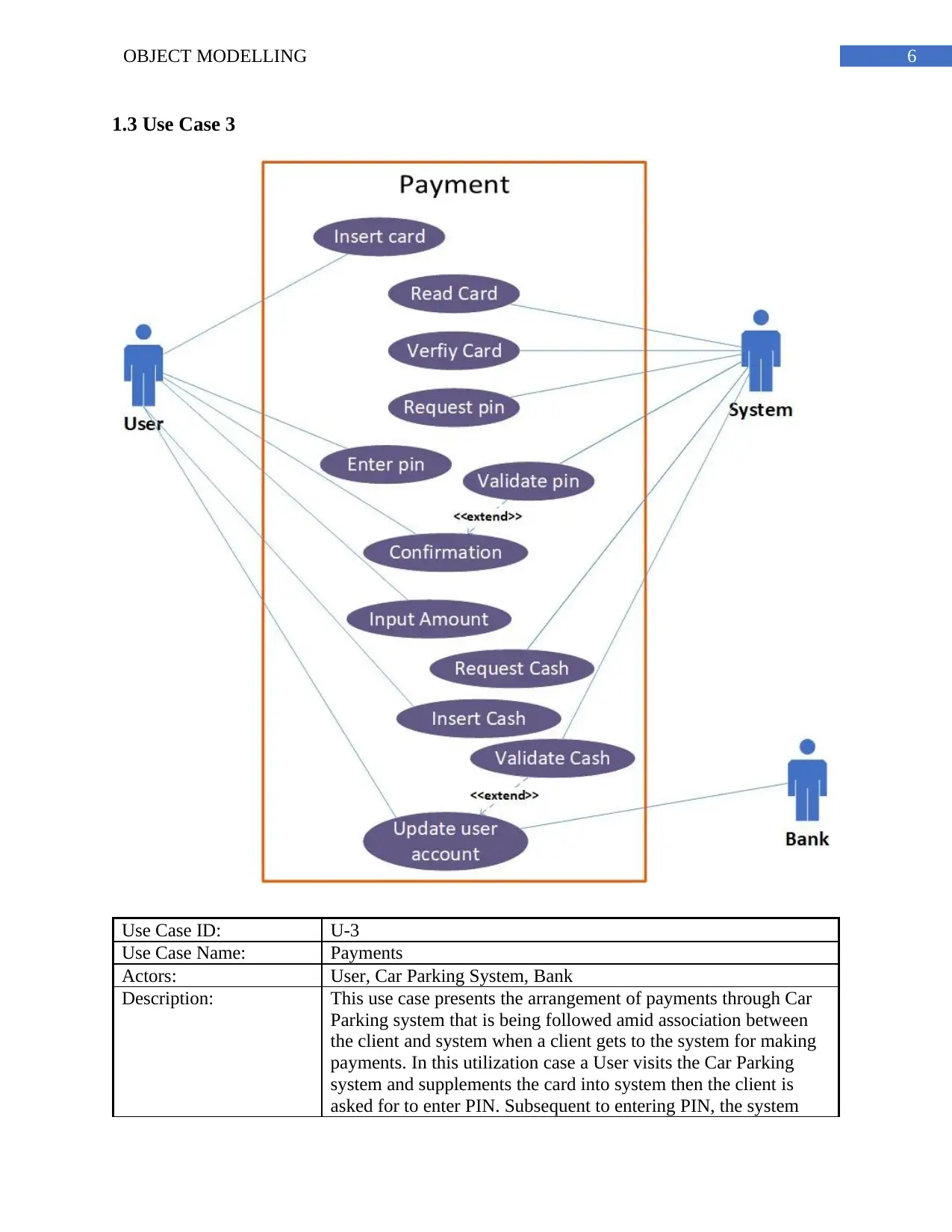
6OBJECT MODELLING
1.3 Use Case 3
Use Case ID: U-3
Use Case Name: Payments
Actors: User, Car Parking System, Bank
Description: This use case presents the arrangement of payments through Car
Parking system that is being followed amid association between
the client and system when a client gets to the system for making
payments. In this utilization case a User visits the Car Parking
system and supplements the card into system then the client is
asked for to enter PIN. Subsequent to entering PIN, the system
1.3 Use Case 3
Use Case ID: U-3
Use Case Name: Payments
Actors: User, Car Parking System, Bank
Description: This use case presents the arrangement of payments through Car
Parking system that is being followed amid association between
the client and system when a client gets to the system for making
payments. In this utilization case a User visits the Car Parking
system and supplements the card into system then the client is
asked for to enter PIN. Subsequent to entering PIN, the system
Paraphrase This Document
Need a fresh take? Get an instant paraphrase of this document with our AI Paraphraser
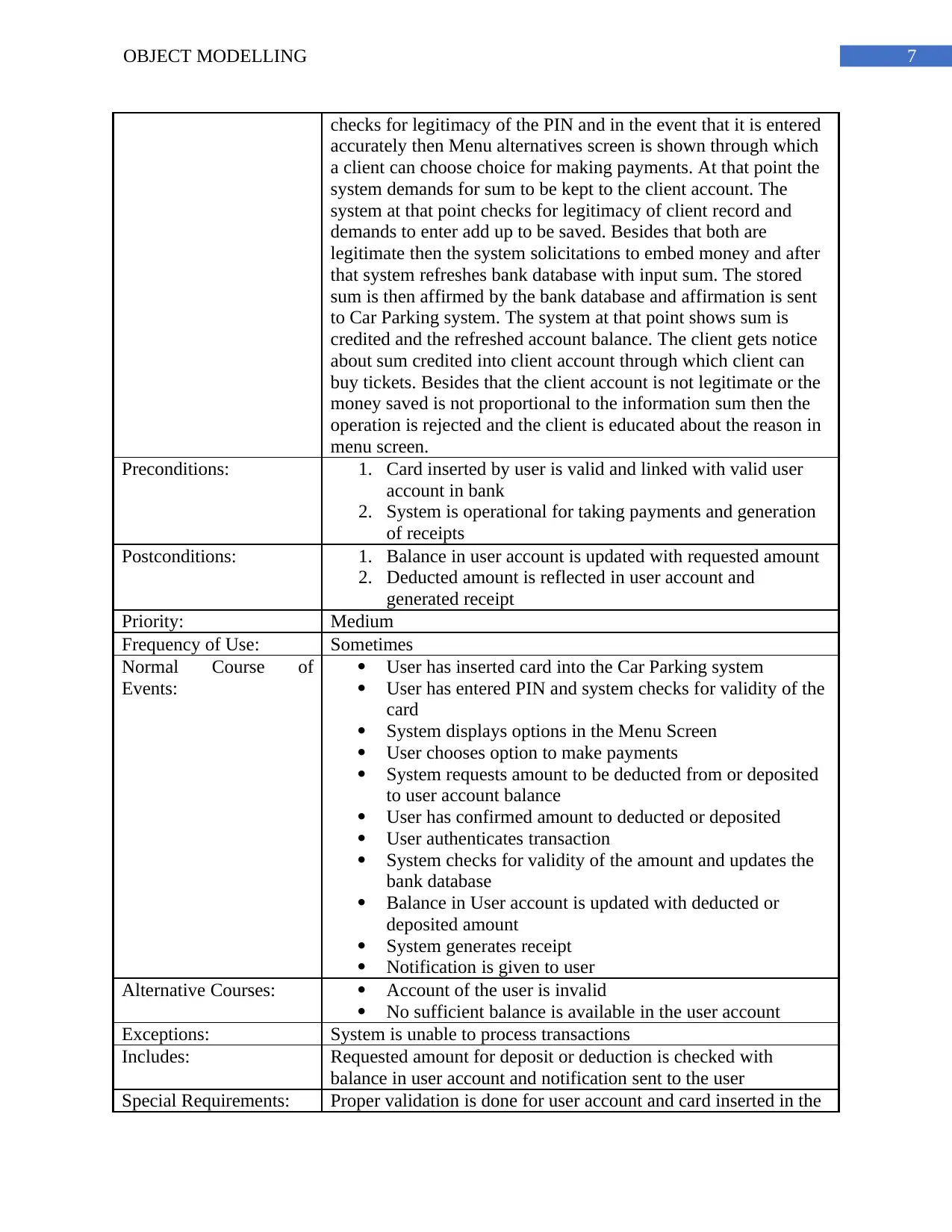
7OBJECT MODELLING
checks for legitimacy of the PIN and in the event that it is entered
accurately then Menu alternatives screen is shown through which
a client can choose choice for making payments. At that point the
system demands for sum to be kept to the client account. The
system at that point checks for legitimacy of client record and
demands to enter add up to be saved. Besides that both are
legitimate then the system solicitations to embed money and after
that system refreshes bank database with input sum. The stored
sum is then affirmed by the bank database and affirmation is sent
to Car Parking system. The system at that point shows sum is
credited and the refreshed account balance. The client gets notice
about sum credited into client account through which client can
buy tickets. Besides that the client account is not legitimate or the
money saved is not proportional to the information sum then the
operation is rejected and the client is educated about the reason in
menu screen.
Preconditions: 1. Card inserted by user is valid and linked with valid user
account in bank
2. System is operational for taking payments and generation
of receipts
Postconditions: 1. Balance in user account is updated with requested amount
2. Deducted amount is reflected in user account and
generated receipt
Priority: Medium
Frequency of Use: Sometimes
Normal Course of
Events:
User has inserted card into the Car Parking system
User has entered PIN and system checks for validity of the
card
System displays options in the Menu Screen
User chooses option to make payments
System requests amount to be deducted from or deposited
to user account balance
User has confirmed amount to deducted or deposited
User authenticates transaction
System checks for validity of the amount and updates the
bank database
Balance in User account is updated with deducted or
deposited amount
System generates receipt
Notification is given to user
Alternative Courses: Account of the user is invalid
No sufficient balance is available in the user account
Exceptions: System is unable to process transactions
Includes: Requested amount for deposit or deduction is checked with
balance in user account and notification sent to the user
Special Requirements: Proper validation is done for user account and card inserted in the
checks for legitimacy of the PIN and in the event that it is entered
accurately then Menu alternatives screen is shown through which
a client can choose choice for making payments. At that point the
system demands for sum to be kept to the client account. The
system at that point checks for legitimacy of client record and
demands to enter add up to be saved. Besides that both are
legitimate then the system solicitations to embed money and after
that system refreshes bank database with input sum. The stored
sum is then affirmed by the bank database and affirmation is sent
to Car Parking system. The system at that point shows sum is
credited and the refreshed account balance. The client gets notice
about sum credited into client account through which client can
buy tickets. Besides that the client account is not legitimate or the
money saved is not proportional to the information sum then the
operation is rejected and the client is educated about the reason in
menu screen.
Preconditions: 1. Card inserted by user is valid and linked with valid user
account in bank
2. System is operational for taking payments and generation
of receipts
Postconditions: 1. Balance in user account is updated with requested amount
2. Deducted amount is reflected in user account and
generated receipt
Priority: Medium
Frequency of Use: Sometimes
Normal Course of
Events:
User has inserted card into the Car Parking system
User has entered PIN and system checks for validity of the
card
System displays options in the Menu Screen
User chooses option to make payments
System requests amount to be deducted from or deposited
to user account balance
User has confirmed amount to deducted or deposited
User authenticates transaction
System checks for validity of the amount and updates the
bank database
Balance in User account is updated with deducted or
deposited amount
System generates receipt
Notification is given to user
Alternative Courses: Account of the user is invalid
No sufficient balance is available in the user account
Exceptions: System is unable to process transactions
Includes: Requested amount for deposit or deduction is checked with
balance in user account and notification sent to the user
Special Requirements: Proper validation is done for user account and card inserted in the
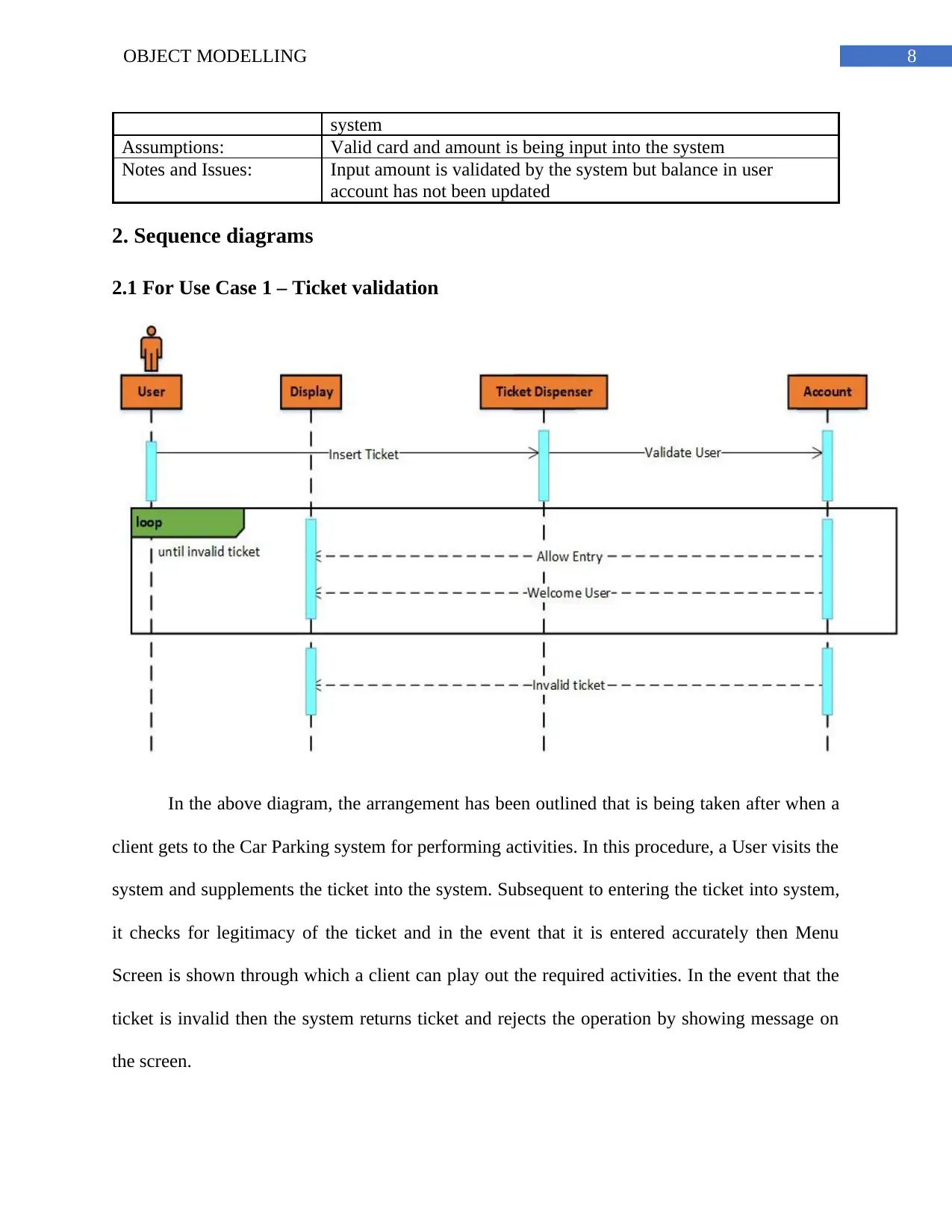
8OBJECT MODELLING
system
Assumptions: Valid card and amount is being input into the system
Notes and Issues: Input amount is validated by the system but balance in user
account has not been updated
2. Sequence diagrams
2.1 For Use Case 1 – Ticket validation
In the above diagram, the arrangement has been outlined that is being taken after when a
client gets to the Car Parking system for performing activities. In this procedure, a User visits the
system and supplements the ticket into the system. Subsequent to entering the ticket into system,
it checks for legitimacy of the ticket and in the event that it is entered accurately then Menu
Screen is shown through which a client can play out the required activities. In the event that the
ticket is invalid then the system returns ticket and rejects the operation by showing message on
the screen.
system
Assumptions: Valid card and amount is being input into the system
Notes and Issues: Input amount is validated by the system but balance in user
account has not been updated
2. Sequence diagrams
2.1 For Use Case 1 – Ticket validation
In the above diagram, the arrangement has been outlined that is being taken after when a
client gets to the Car Parking system for performing activities. In this procedure, a User visits the
system and supplements the ticket into the system. Subsequent to entering the ticket into system,
it checks for legitimacy of the ticket and in the event that it is entered accurately then Menu
Screen is shown through which a client can play out the required activities. In the event that the
ticket is invalid then the system returns ticket and rejects the operation by showing message on
the screen.
⊘ This is a preview!⊘
Do you want full access?
Subscribe today to unlock all pages.

Trusted by 1+ million students worldwide
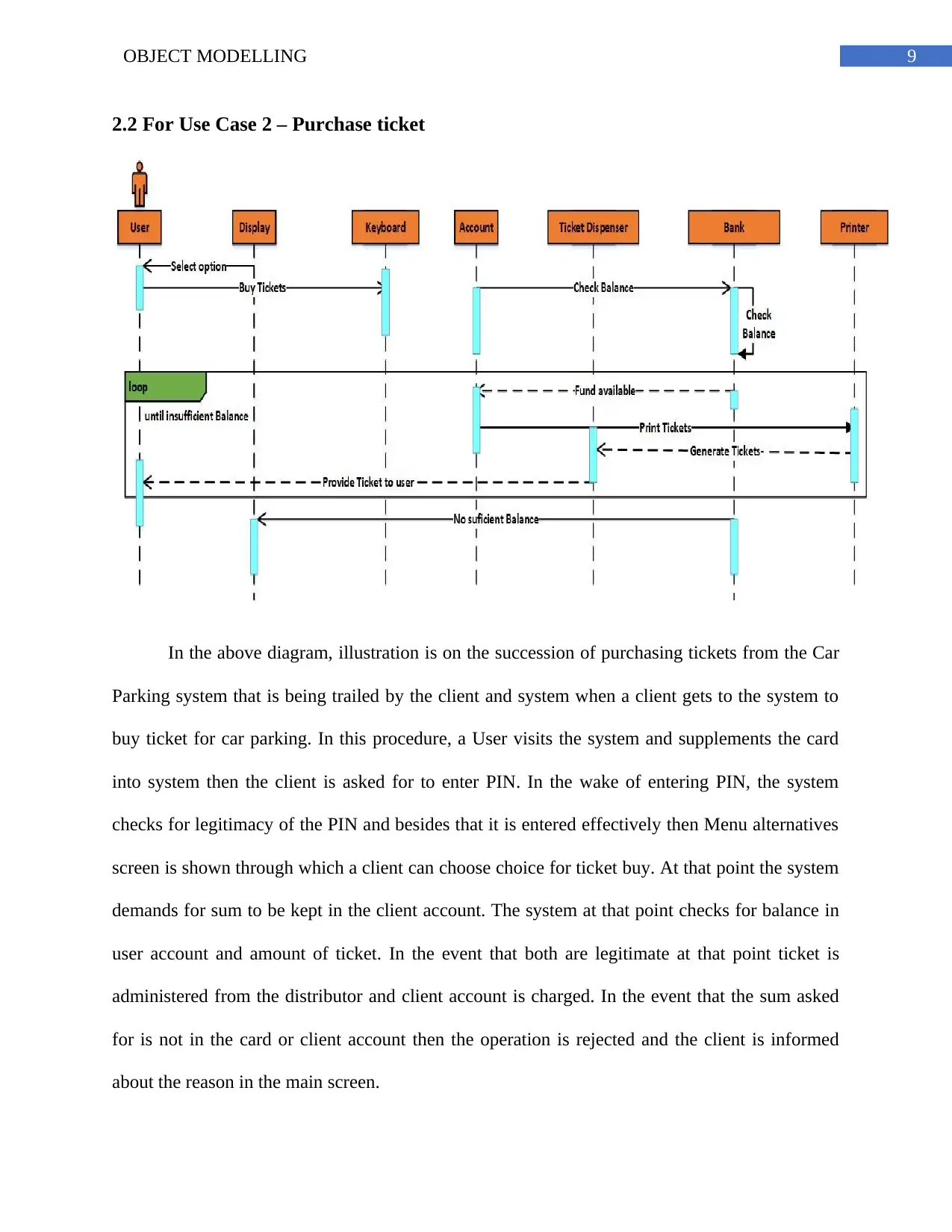
9OBJECT MODELLING
2.2 For Use Case 2 – Purchase ticket
In the above diagram, illustration is on the succession of purchasing tickets from the Car
Parking system that is being trailed by the client and system when a client gets to the system to
buy ticket for car parking. In this procedure, a User visits the system and supplements the card
into system then the client is asked for to enter PIN. In the wake of entering PIN, the system
checks for legitimacy of the PIN and besides that it is entered effectively then Menu alternatives
screen is shown through which a client can choose choice for ticket buy. At that point the system
demands for sum to be kept in the client account. The system at that point checks for balance in
user account and amount of ticket. In the event that both are legitimate at that point ticket is
administered from the distributor and client account is charged. In the event that the sum asked
for is not in the card or client account then the operation is rejected and the client is informed
about the reason in the main screen.
2.2 For Use Case 2 – Purchase ticket
In the above diagram, illustration is on the succession of purchasing tickets from the Car
Parking system that is being trailed by the client and system when a client gets to the system to
buy ticket for car parking. In this procedure, a User visits the system and supplements the card
into system then the client is asked for to enter PIN. In the wake of entering PIN, the system
checks for legitimacy of the PIN and besides that it is entered effectively then Menu alternatives
screen is shown through which a client can choose choice for ticket buy. At that point the system
demands for sum to be kept in the client account. The system at that point checks for balance in
user account and amount of ticket. In the event that both are legitimate at that point ticket is
administered from the distributor and client account is charged. In the event that the sum asked
for is not in the card or client account then the operation is rejected and the client is informed
about the reason in the main screen.
Paraphrase This Document
Need a fresh take? Get an instant paraphrase of this document with our AI Paraphraser
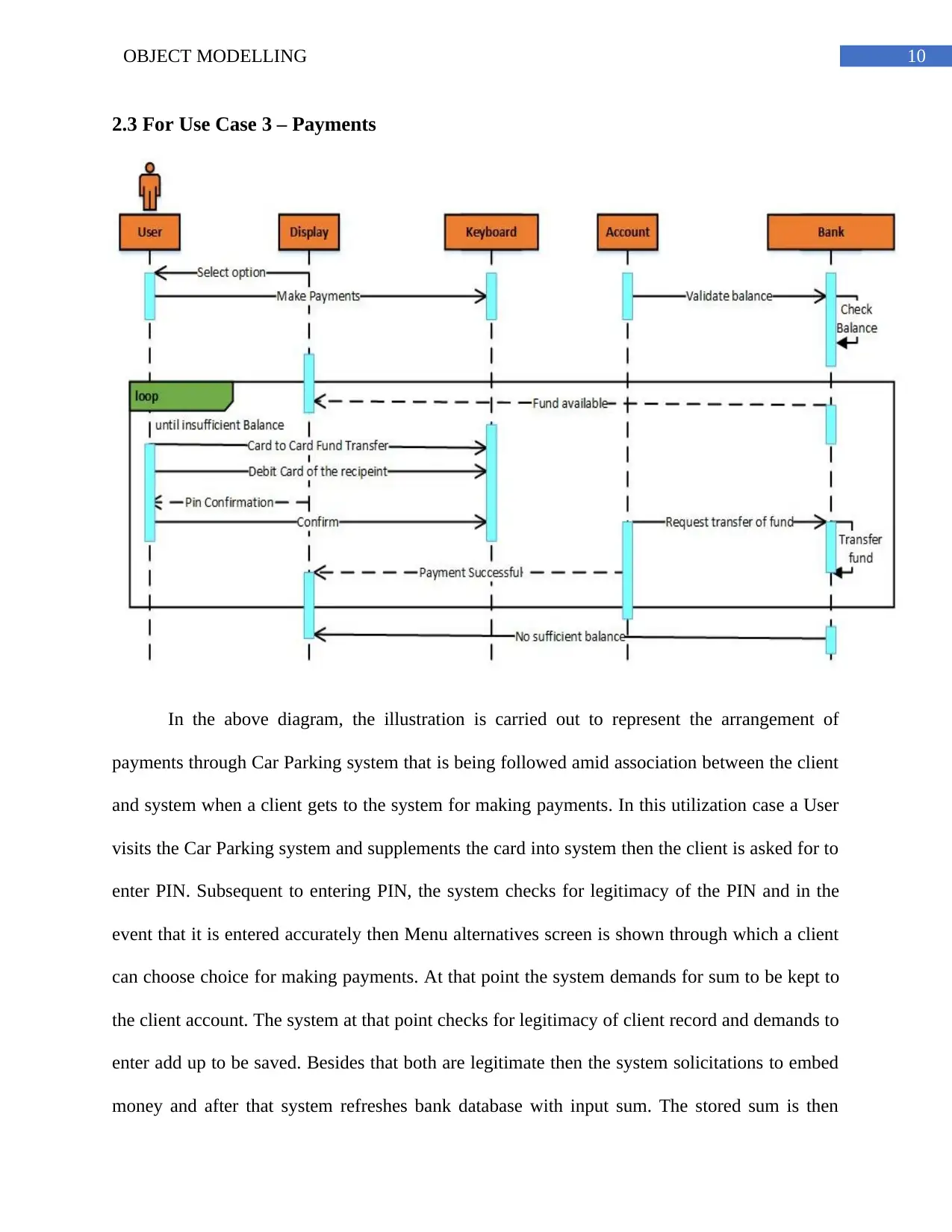
10OBJECT MODELLING
2.3 For Use Case 3 – Payments
In the above diagram, the illustration is carried out to represent the arrangement of
payments through Car Parking system that is being followed amid association between the client
and system when a client gets to the system for making payments. In this utilization case a User
visits the Car Parking system and supplements the card into system then the client is asked for to
enter PIN. Subsequent to entering PIN, the system checks for legitimacy of the PIN and in the
event that it is entered accurately then Menu alternatives screen is shown through which a client
can choose choice for making payments. At that point the system demands for sum to be kept to
the client account. The system at that point checks for legitimacy of client record and demands to
enter add up to be saved. Besides that both are legitimate then the system solicitations to embed
money and after that system refreshes bank database with input sum. The stored sum is then
2.3 For Use Case 3 – Payments
In the above diagram, the illustration is carried out to represent the arrangement of
payments through Car Parking system that is being followed amid association between the client
and system when a client gets to the system for making payments. In this utilization case a User
visits the Car Parking system and supplements the card into system then the client is asked for to
enter PIN. Subsequent to entering PIN, the system checks for legitimacy of the PIN and in the
event that it is entered accurately then Menu alternatives screen is shown through which a client
can choose choice for making payments. At that point the system demands for sum to be kept to
the client account. The system at that point checks for legitimacy of client record and demands to
enter add up to be saved. Besides that both are legitimate then the system solicitations to embed
money and after that system refreshes bank database with input sum. The stored sum is then
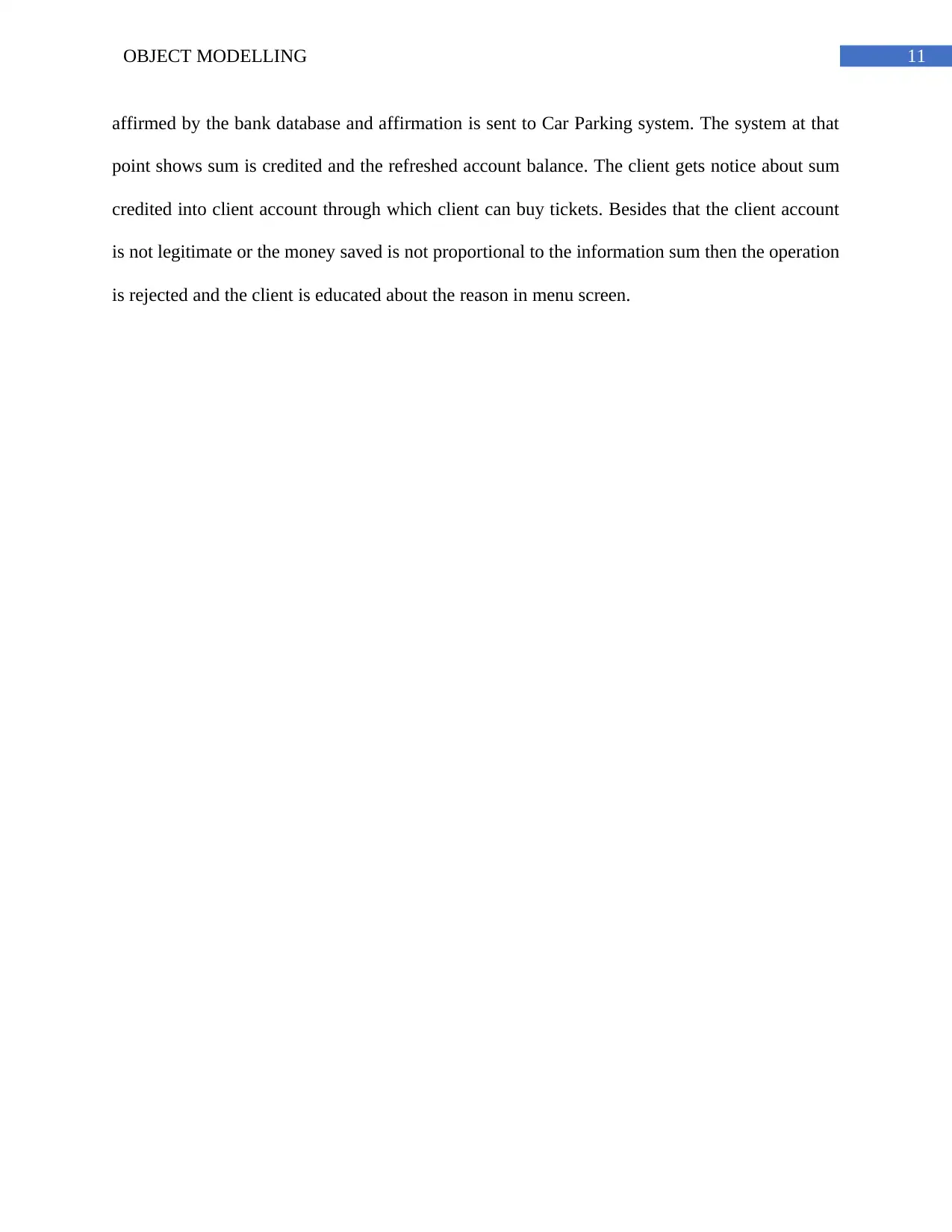
11OBJECT MODELLING
affirmed by the bank database and affirmation is sent to Car Parking system. The system at that
point shows sum is credited and the refreshed account balance. The client gets notice about sum
credited into client account through which client can buy tickets. Besides that the client account
is not legitimate or the money saved is not proportional to the information sum then the operation
is rejected and the client is educated about the reason in menu screen.
affirmed by the bank database and affirmation is sent to Car Parking system. The system at that
point shows sum is credited and the refreshed account balance. The client gets notice about sum
credited into client account through which client can buy tickets. Besides that the client account
is not legitimate or the money saved is not proportional to the information sum then the operation
is rejected and the client is educated about the reason in menu screen.
⊘ This is a preview!⊘
Do you want full access?
Subscribe today to unlock all pages.

Trusted by 1+ million students worldwide
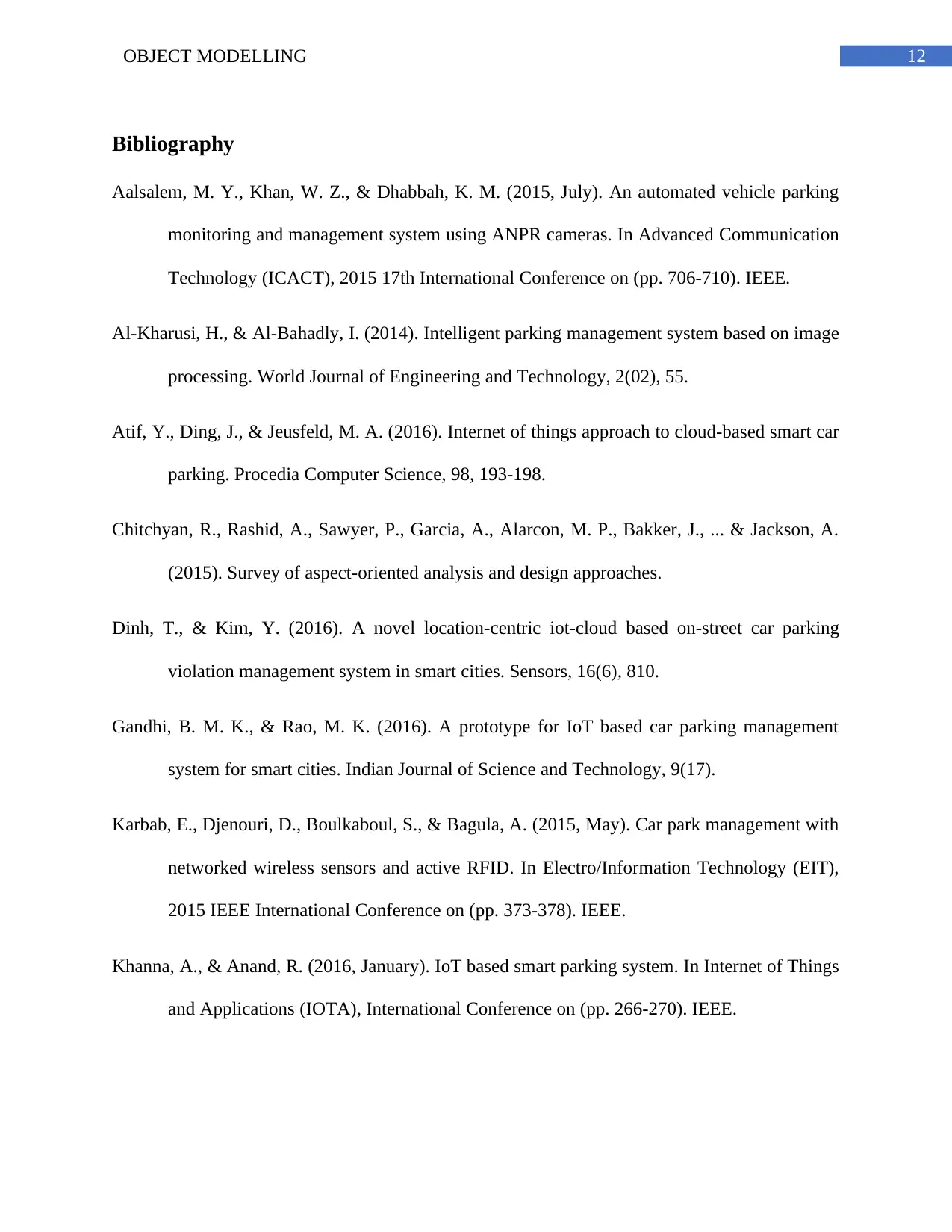
12OBJECT MODELLING
Bibliography
Aalsalem, M. Y., Khan, W. Z., & Dhabbah, K. M. (2015, July). An automated vehicle parking
monitoring and management system using ANPR cameras. In Advanced Communication
Technology (ICACT), 2015 17th International Conference on (pp. 706-710). IEEE.
Al-Kharusi, H., & Al-Bahadly, I. (2014). Intelligent parking management system based on image
processing. World Journal of Engineering and Technology, 2(02), 55.
Atif, Y., Ding, J., & Jeusfeld, M. A. (2016). Internet of things approach to cloud-based smart car
parking. Procedia Computer Science, 98, 193-198.
Chitchyan, R., Rashid, A., Sawyer, P., Garcia, A., Alarcon, M. P., Bakker, J., ... & Jackson, A.
(2015). Survey of aspect-oriented analysis and design approaches.
Dinh, T., & Kim, Y. (2016). A novel location-centric iot-cloud based on-street car parking
violation management system in smart cities. Sensors, 16(6), 810.
Gandhi, B. M. K., & Rao, M. K. (2016). A prototype for IoT based car parking management
system for smart cities. Indian Journal of Science and Technology, 9(17).
Karbab, E., Djenouri, D., Boulkaboul, S., & Bagula, A. (2015, May). Car park management with
networked wireless sensors and active RFID. In Electro/Information Technology (EIT),
2015 IEEE International Conference on (pp. 373-378). IEEE.
Khanna, A., & Anand, R. (2016, January). IoT based smart parking system. In Internet of Things
and Applications (IOTA), International Conference on (pp. 266-270). IEEE.
Bibliography
Aalsalem, M. Y., Khan, W. Z., & Dhabbah, K. M. (2015, July). An automated vehicle parking
monitoring and management system using ANPR cameras. In Advanced Communication
Technology (ICACT), 2015 17th International Conference on (pp. 706-710). IEEE.
Al-Kharusi, H., & Al-Bahadly, I. (2014). Intelligent parking management system based on image
processing. World Journal of Engineering and Technology, 2(02), 55.
Atif, Y., Ding, J., & Jeusfeld, M. A. (2016). Internet of things approach to cloud-based smart car
parking. Procedia Computer Science, 98, 193-198.
Chitchyan, R., Rashid, A., Sawyer, P., Garcia, A., Alarcon, M. P., Bakker, J., ... & Jackson, A.
(2015). Survey of aspect-oriented analysis and design approaches.
Dinh, T., & Kim, Y. (2016). A novel location-centric iot-cloud based on-street car parking
violation management system in smart cities. Sensors, 16(6), 810.
Gandhi, B. M. K., & Rao, M. K. (2016). A prototype for IoT based car parking management
system for smart cities. Indian Journal of Science and Technology, 9(17).
Karbab, E., Djenouri, D., Boulkaboul, S., & Bagula, A. (2015, May). Car park management with
networked wireless sensors and active RFID. In Electro/Information Technology (EIT),
2015 IEEE International Conference on (pp. 373-378). IEEE.
Khanna, A., & Anand, R. (2016, January). IoT based smart parking system. In Internet of Things
and Applications (IOTA), International Conference on (pp. 266-270). IEEE.
Paraphrase This Document
Need a fresh take? Get an instant paraphrase of this document with our AI Paraphraser
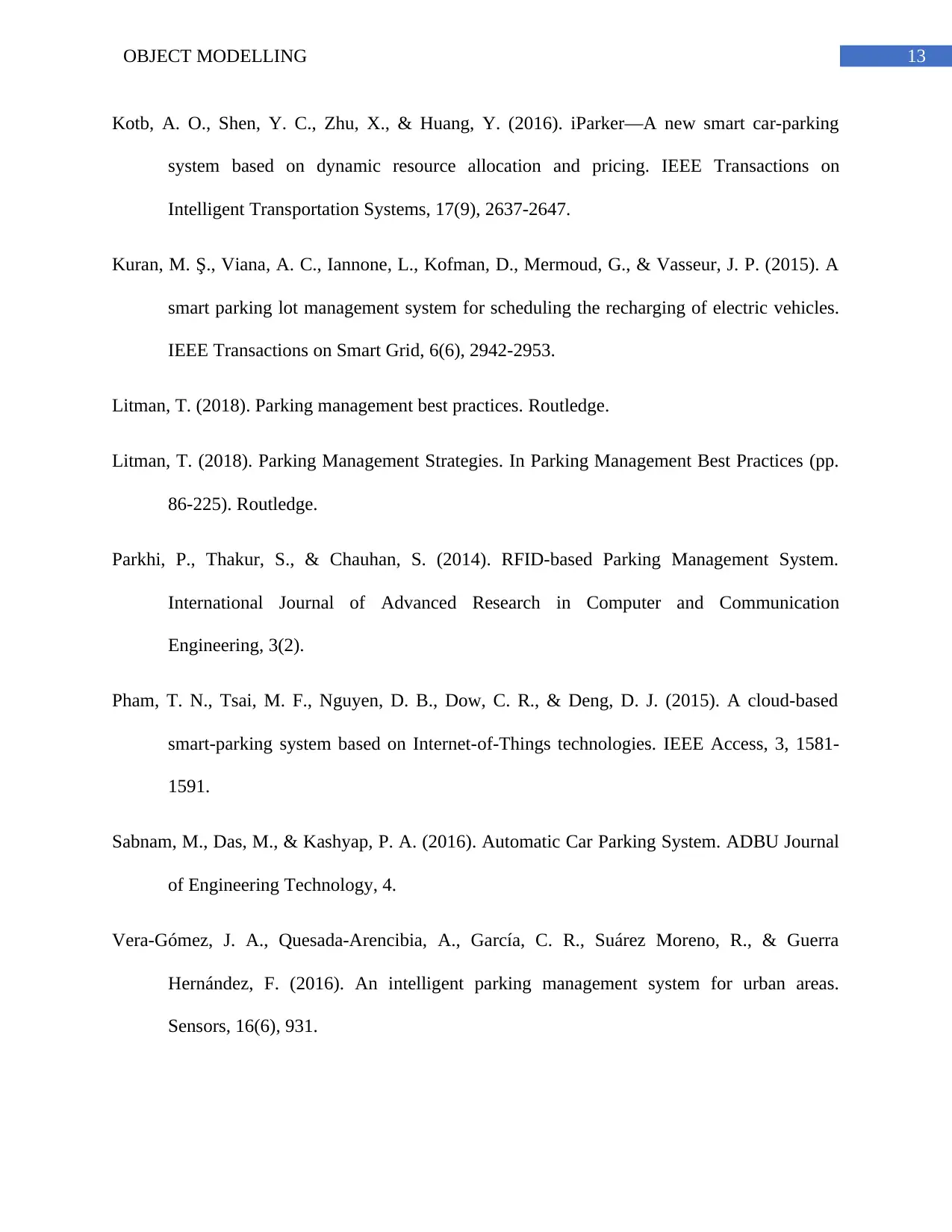
13OBJECT MODELLING
Kotb, A. O., Shen, Y. C., Zhu, X., & Huang, Y. (2016). iParker—A new smart car-parking
system based on dynamic resource allocation and pricing. IEEE Transactions on
Intelligent Transportation Systems, 17(9), 2637-2647.
Kuran, M. Ş., Viana, A. C., Iannone, L., Kofman, D., Mermoud, G., & Vasseur, J. P. (2015). A
smart parking lot management system for scheduling the recharging of electric vehicles.
IEEE Transactions on Smart Grid, 6(6), 2942-2953.
Litman, T. (2018). Parking management best practices. Routledge.
Litman, T. (2018). Parking Management Strategies. In Parking Management Best Practices (pp.
86-225). Routledge.
Parkhi, P., Thakur, S., & Chauhan, S. (2014). RFID-based Parking Management System.
International Journal of Advanced Research in Computer and Communication
Engineering, 3(2).
Pham, T. N., Tsai, M. F., Nguyen, D. B., Dow, C. R., & Deng, D. J. (2015). A cloud-based
smart-parking system based on Internet-of-Things technologies. IEEE Access, 3, 1581-
1591.
Sabnam, M., Das, M., & Kashyap, P. A. (2016). Automatic Car Parking System. ADBU Journal
of Engineering Technology, 4.
Vera-Gómez, J. A., Quesada-Arencibia, A., García, C. R., Suárez Moreno, R., & Guerra
Hernández, F. (2016). An intelligent parking management system for urban areas.
Sensors, 16(6), 931.
Kotb, A. O., Shen, Y. C., Zhu, X., & Huang, Y. (2016). iParker—A new smart car-parking
system based on dynamic resource allocation and pricing. IEEE Transactions on
Intelligent Transportation Systems, 17(9), 2637-2647.
Kuran, M. Ş., Viana, A. C., Iannone, L., Kofman, D., Mermoud, G., & Vasseur, J. P. (2015). A
smart parking lot management system for scheduling the recharging of electric vehicles.
IEEE Transactions on Smart Grid, 6(6), 2942-2953.
Litman, T. (2018). Parking management best practices. Routledge.
Litman, T. (2018). Parking Management Strategies. In Parking Management Best Practices (pp.
86-225). Routledge.
Parkhi, P., Thakur, S., & Chauhan, S. (2014). RFID-based Parking Management System.
International Journal of Advanced Research in Computer and Communication
Engineering, 3(2).
Pham, T. N., Tsai, M. F., Nguyen, D. B., Dow, C. R., & Deng, D. J. (2015). A cloud-based
smart-parking system based on Internet-of-Things technologies. IEEE Access, 3, 1581-
1591.
Sabnam, M., Das, M., & Kashyap, P. A. (2016). Automatic Car Parking System. ADBU Journal
of Engineering Technology, 4.
Vera-Gómez, J. A., Quesada-Arencibia, A., García, C. R., Suárez Moreno, R., & Guerra
Hernández, F. (2016). An intelligent parking management system for urban areas.
Sensors, 16(6), 931.
1 out of 14
Related Documents
Your All-in-One AI-Powered Toolkit for Academic Success.
+13062052269
info@desklib.com
Available 24*7 on WhatsApp / Email
![[object Object]](/_next/static/media/star-bottom.7253800d.svg)
Unlock your academic potential
© 2024 | Zucol Services PVT LTD | All rights reserved.



